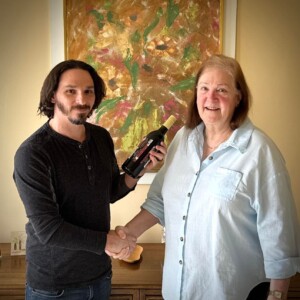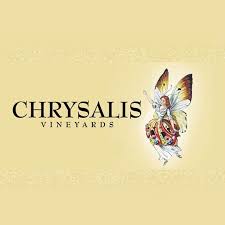Chrysalis Vineyards

Jake Blodinger & Jennifer McCloud
About
Owner: Jennifer McCloud
Winemaker: Jake Blodinger
Vineyards: 70 acres (28.3ha) across two vineyard sites, one at the estate and one at higher elevation in the Blue Ridge
Vineyard management: Sustainable, working since 2020 to eliminate all synthetic inputs
Soils: Greenstone
Grapes grown: Norton, Albarino, Viognier, Petit Manseng, Petit Verdot, Tannat, Nebbiolo, Tinta Cao, Tempranillo, Graziano, Verdejo
Quick facts:
- Chrysalis is home to the world’s largest planting of Norton, a native Virginian grape that was considered one of the best red wine grapes in the world in the 1800s before it was nearly forgotten during Prohibition. Its thick skins and strong disease resistance make it perfectly suited to Virginia’s climate, requiring little to no chemical treatment.
- Beyond viticulture, Chrysalis is also home to the second oldest continually operating commercial dairy in Virginia, and they produce a variety of artisanal cheeses.
- “I want to focus on varieties that can stand on their own merits on a world stage without any explanation or excuse, no ‘for Virginia.’ I’d rather make the world’s best Norton than the world’s 400th best Merlot. It’s a great grape, it’s ours, we should be promoting it!” – Jennifer McCloud
Jennifer McCloud established Chrysalis in 1997. While most of her peers in Virginia at the time were chasing the idols of Bordeaux and Napa, she went in a totally different direction: she planted Norton. The idea came from a conference she attended in Charlottesville about alternative varieties, and she was inspired by the idea of planting a native grape that was designed to thrive in Virginia.
“I want to focus on varieties that can stand on their own merits on a world stage without any explanation or excuse, no ‘for Virginia,'” Jenni asserts. “I’d rather make the world’s best Norton than the world’s 400th best Merlot.”
The Norton grape variety was developed in 1820 in Richmond, Virginia by Daniel Norton. He was trying to create a native American grape capable of producing fine wines, after many attempts of planting vinifera grapes in America had failed (due to the as-yet undiscovered phylloxera louse). Its parentage is lost, but it’s believed to have included some vinifera, making it technically a hybrid, although it is generally thought of as a “native” American grape. Norton was considered among the best red wines in the world in the 19th century–Stone Hill Winery in Missouri was the third largest winery in the world in the late 1800s, producing primarily Norton. Unfortunately, in the early 20th century, Prohibition decimated the American wine industry, and plantings of Norton in particular, and it never really caught back on.
Norton is the most disease-resistant grape variety in the world–not just among wine grapes, but among table grapes and raisin grapes as well. Its thick skins and high levels of resveratrol provide excellent defense against fungal or bacterial invasion. In fact, it’s so resistant that if there is a spot of fungus on the leaf, the vine will create a ring of dead tissue around it to isolate it and prevent its spread. Furthermore, budbreak for Norton is about two weeks later than most vinifera grapes, so there’s a minimal risk of spring frost damage. Its disadvantages include the fact that it’s difficult to propagate from cuttings, and it’s a slow grower and slow to come into fruiting–a main factor as to why it wasn’t widely replanted after Prohibition. As a wine, it has great color, great fruit intensity, and great acidity, and high but soft tannins. A tendency towards hollowness in the midpalate can be mitigated through thoughtful winemaking techniques and blending with other varieties.
Today, at 40 acres across eight different blocks, Chrysalis has the largest planting of Norton in the world, and it’s also a commercial nursery for the grape.
Why Norton? “It’s unique! It’s Virginia’s own native grape! It has a low environmental impact–it wants to grow here, we don’t have to coax it or cajole it,” Jenni says.”It’s a great grape, it’s ours, we should be promoting it!”
There are two main vineyard sites at Chrysalis, one right at the estate, and the other across Loudoun Valley in the Blue Ridge Mountains, at 1100-1250ft elevation. Most of the vinifera is planted at the Blue Ridge site, while most of the Norton is planted at the estate. The soils are primarily greenstone, deep and well-draining. The most important factor for site selection is air drainage: it’s crucial to avoid sites where cold air settles, causing devastating spring frost damage, and good airflow also mitigates the risk of fungal disease in the humid climate. Within these two sites are various blocks with different microclimates, leading to different chemistry compositions in the grapes. Therefore, even the 100% Norton wines are still blended, taking advantage of the different characteristics of each block to create a harmonious final wine.
“If you plant Norton in the worst spot, it’ll still grow. But what we’ve done here is plant Norton in the best spots, and it does exceptionally well–that’s why our quality is so much higher than most,” Jenni explains.
Jake joined the team at Chrysalis as full-time winemaker in 2019; prior to that, Jenni had worked with a consultant. His approach since 2020 has been to strip out all additives and all synthetics from the vineyards, and from the rest of the property as well. Norton’s strong disease resistance allows them to focus their vineyard work less on chemical use and more on canopy and soil care. Since his arrival, Jake has brought new winemaking techniques, including carbonic maceration, and a deeper understanding of the “personality” of each vineyard block, in order to showcase Norton to its greatest advantage.
“I’m as excited to be making Nortons now as I’ve ever been, and I’ve been at this now for close to 30 years,” Jenni tells us.
Beyond Norton, Jenni has planted an assortment of grapes less commonly seen in Virginia, with a focus on varieties that are naturally well-suited to the local climate. She was the first to introduce Albarino to the US when she planted her initial cuttings in 1996. Native to the humid Galicia region of Spain, it has naturally thick skins and loose clusters, making it more resistant to the fungal diseases that are the main challenge in Virginia. She was initially worried about its cold hardiness in the harsher Virginia winters, but it has thrived, and Chrysalis is now the source of all the Albarino cuttings planted on the East Coast.
Albarino is not the only Spanish grape that’s found a home at Chrysalis–Jenni also brought over the first plantings of Tempranillo and Graziano, and has planted Tinta Cao, Nebbiolo, Petit Verdot, and Tannat from elsewhere in southern Europe as well. These other red grapes have been selected not only for their suitability for the climate but also for their complementary characteristics as a blending partner with Norton: they add structure, tannin, and midpalate to balance Norton’s fruitiness and high acidity.
Chrysalis was also the site of the first commercial Petit Manseng planting in the US, and Jenni was responsible for petitioning the TTB to allow “Petit Manseng” as a varietally-labeled wine in America back in 2001. Another grape naturally well-suited to Virginia due to its thick skins and loose clusters, it’s been catching on as a dry wine in other parts of the state, but Jenni prefers to vinify it as a dessert wine due to its tendency towards high acid and high sugar levels.
Chrysalis has also made a name for itself for its Viognier: “We worked with Alan Kelley, who taught America how to make Viognier, and we’ve been making native-fermented Viognier since 1997,” Jenni tells us. They pick at full physiological ripeness for the peachy and tropical flavors, then ferment at cool temperatures in neutral barrels to preserve the aromatics.
“Our climate produces fruit-forward wines, we should embrace that instead of battling for a mineral style that doesn’t come naturally,” Jenni explains. “Our goal is simply to maximize the quality of the wine from the characteristics brought in from our climate and our vineyards.”

